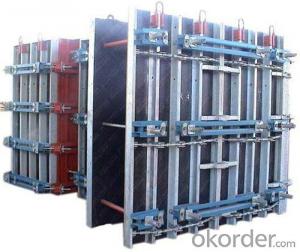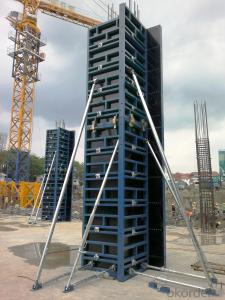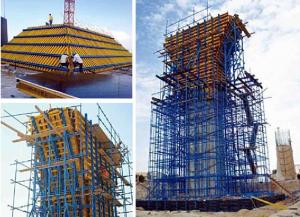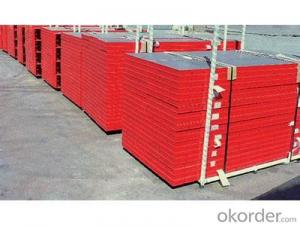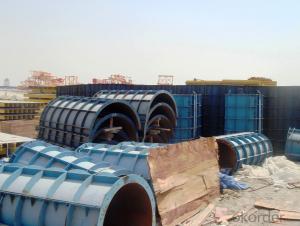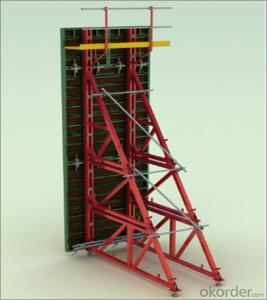Steel Frame Formwork-Column Formwork from CNBM China
- Loading Port:
- China main port
- Payment Terms:
- TT OR LC
- Min Order Qty:
- 1000 m²
- Supply Capability:
- 50000 m²/month
OKorder Service Pledge
OKorder Financial Service
You Might Also Like
1. Structure of Steel Frame Formwork
There is a prizing part designed in the corner, which can help to position and remove formwork easily.
The plywood is screwed on from the back when connecting frame and plywood, so the surface of the finished concrete is perfect.
The formwork series are a complete system with a full set of accessories, and can be set up flexibly according to project demand.
2. Main Features of Steel Frame Formwork
Light weight
High strength
High standardized system
Easy connection with adjustable steel clamp
Convenient and fast corner formwork
Flexible to assemble and application
3. Steel Frame Formwork Images
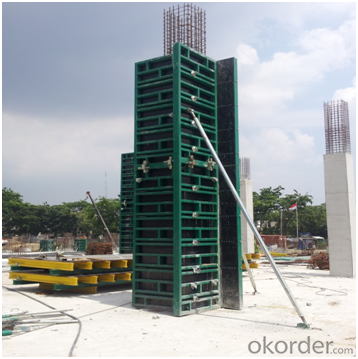
4. Steel Frame Formwork GK120 Specification
-The steel frame formwork is plywood covered with hollow steel. The plywood is 18 mm thick.
-The frame is highly strengthened, and the wall formwork can bear lateral pressure 60 KN/m2 while the column formwork can bear 80 KN/m2.
-As a standardized system, it is flexible to assemble , wood batten can be filled to satisfy the need f of non-standard size.
-The adjustable steel clamp is convenient to use, and can hold tightly.
-There is a prizing part designed in the corner, which can help to position and remove formwork easily.
-The plywood is screwed on from the back when connecting frame and plywood, so the surface of the finished concrete is perfect.
-The formwork series are a complete system with a full set of accessories, and can be set up flexibly according to project demand.
5. FAQ of Steel Frame Formwork GK120
1) What can we do for you?
.We can ensure the quality of the vinyl banner and avoid extra expenses for customers.
.We can provide you the professional design team.
.We can provide fashionable and newest styles for you.
.We can design the artwork for you.
. Please feel free to customize.
2) What promises can be done by us?
. If interested in Steel Frame Formwork GK120, please feel free to write us for any QUOTE.
. If printing required, please advise asap because the whole set need much more time to complete.
. Please DO check goods when courier knocks your door and contact us asap if any issue.
- Q:What are the different types of concrete release agents used with steel frame formwork?
- There are several different types of concrete release agents that can be used with steel frame formwork. These release agents are applied to the surface of the formwork to prevent the concrete from sticking to it during the pouring and curing process. One common type of release agent is a petroleum-based product. These agents are typically oil-based and provide a barrier between the formwork and the concrete. They are easy to apply and provide a smooth release, allowing for easy removal of the formwork once the concrete has cured. However, petroleum-based release agents can be flammable and may have a negative impact on the environment. Another type of concrete release agent is a water-based product. These agents are typically made from a combination of water, surfactants, and other additives. They are non-toxic and environmentally friendly, making them a popular choice for many contractors. Water-based release agents are easy to apply and provide a clean release, leaving little or no residue on the formwork. There are also specialty release agents available for specific applications. For example, some release agents are designed to provide a textured finish on the concrete surface, while others are formulated for use with colored or decorative concrete. These specialty agents can help achieve specific desired finishes or appearances. In addition to the different types of release agents, there are also different forms in which they can be applied. Some release agents come in liquid form, which can be sprayed or brushed onto the formwork. Others come in the form of a release agent film or tape, which can be applied directly to the formwork surface. The choice of application method will depend on the specific requirements of the project and the preferences of the contractor. Overall, the different types of concrete release agents used with steel frame formwork offer a range of options to ensure easy and efficient removal of the formwork and a smooth, clean finish on the concrete surface. Contractors should consider factors such as environmental impact, ease of application, and desired finish when selecting the appropriate release agent for their project.
- Q:How does steel frame formwork contribute to the overall sustainability of the built environment?
- Steel frame formwork contributes to the overall sustainability of the built environment in several ways. Firstly, steel is a highly durable and long-lasting material, which means that steel formwork systems can be reused multiple times. This reduces the need for virgin materials and minimizes waste generation, lowering the overall carbon footprint of construction projects. Additionally, steel formwork is lightweight and easy to assemble, which increases construction efficiency and reduces the time and energy required for building processes. Lastly, steel is a recyclable material, and at the end of its life cycle as formwork, it can be recycled and used in the production of new steel products, further reducing the environmental impact of the built environment. Overall, the use of steel frame formwork promotes sustainability by minimizing resource consumption, waste generation, and energy use in construction projects.
- Q:What are the common quality assurance procedures for steel frame formwork systems?
- Common quality assurance procedures for steel frame formwork systems include: 1. Material Inspection: This involves checking the quality and specifications of the steel used in the formwork system, ensuring it meets the required standards and is free from any defects. 2. Welding Inspection: As steel frame formwork systems are typically welded together, it is essential to inspect the welding quality. This includes checking for proper weld penetration, absence of cracks or porosity, and ensuring that the welds are strong and secure. 3. Dimensional Accuracy: The formwork system should be closely inspected to ensure that it meets the required dimensions and tolerances. This includes checking the alignment of the steel frames, the straightness of the members, and the accuracy of the formwork structure as a whole. 4. Load Testing: Load testing is performed to determine the structural integrity and load-bearing capacity of the formwork system. This involves subjecting the system to various loads and ensuring that it can withstand them without any deformation or failure. 5. Surface Coating Inspection: Steel frame formwork systems are often coated with protective paints or coatings to prevent corrosion and enhance durability. These coatings should be inspected to ensure proper coverage, adhesion, and protection against corrosion. 6. Documentation and Certification: Quality assurance procedures also involve proper documentation and certification of the formwork system. This includes keeping records of inspections, test results, and certifications from third-party testing agencies to demonstrate compliance with industry standards and regulations. 7. Continuous Monitoring: Quality assurance procedures also involve continuous monitoring and surveillance of the formwork system during its use. This includes regular inspections, maintenance, and repairs to ensure that the system remains in optimal condition and can perform its intended function safely and efficiently. By implementing these quality assurance procedures, steel frame formwork systems can be ensured to meet the required standards, providing a reliable and durable solution for construction projects.
- Q:What are the different types of formwork braces used in steel frame formwork systems?
- There are several different types of formwork braces that are commonly used in steel frame formwork systems. These braces are essential for providing stability and support to the formwork during the pouring and curing of concrete. 1. Adjustable Steel Braces: These braces are made of steel and are adjustable in length. They are commonly used to provide horizontal support to the formwork system. The adjustable feature allows for flexibility in terms of adapting to different formwork heights. 2. Push-Pull Props: Push-pull props, also known as shore props or acrow props, are telescopic tubular supports that are used to provide vertical support to the formwork. They can be easily adjusted to the desired height and are commonly used in conjunction with adjustable steel braces. 3. Strut Braces: Strut braces consist of steel tubes that are connected to the formwork system diagonally. These braces provide diagonal support and help to prevent lateral movement of the formwork. They are particularly useful when the formwork is exposed to high wind loads or when there is a need for additional support. 4. Cross Braces: Cross braces are steel bars that are used to connect vertical formwork elements together. They provide lateral stability to the formwork system and help to maintain the desired form and shape during the concrete pouring process. 5. Corner Braces: Corner braces are specifically designed to provide support at the corners of the formwork system. They help to ensure that the formwork remains stable and square during the concrete pouring and curing process. 6. Tension Rods: Tension rods are used to provide additional support and stability to the formwork system. They are commonly used in conjunction with other braces, such as adjustable steel braces or strut braces, to reinforce the overall strength of the formwork. These are some of the different types of formwork braces that are used in steel frame formwork systems. The specific type and combination of braces used will depend on factors such as the size and complexity of the formwork, the load requirements, and the environmental conditions at the construction site.
- Q:What are the different types of form stripping methods used with steel frame formwork?
- There are several types of form stripping methods used with steel frame formwork, including crane stripping, hydraulic stripping, and manual stripping. Crane stripping involves using a crane to lift and remove the formwork panels, while hydraulic stripping utilizes hydraulic systems to detach the formwork from the concrete structure. Manual stripping, on the other hand, involves manually dismantling the formwork components. These different methods offer flexibility and efficiency in the formwork removal process, depending on the project requirements and available resources.
- Q:How does steel frame formwork prevent the formation of concrete shrinkage cracks?
- Steel frame formwork prevents the formation of concrete shrinkage cracks by providing strong and rigid support to the concrete during the curing process. It ensures that the concrete remains in its desired shape and position, preventing any movement or displacement that could lead to crack formation. Additionally, the steel frame formwork helps in evenly distributing the forces and stresses exerted by the curing concrete, minimizing the potential for shrinkage cracks to develop.
- Q:How does steel frame formwork contribute to the overall strength and stability of a concrete structure?
- Steel frame formwork contributes to the overall strength and stability of a concrete structure by providing a rigid and durable framework for the concrete to be poured into. It ensures that the concrete is poured in the desired shape and dimensions, preventing any deformations or collapses during the pouring and curing process. The steel frame formwork also helps distribute the weight and loads evenly, improving the structural integrity of the concrete structure and making it more resistant to external forces such as wind or seismic activity.
- Q:How does steel frame formwork handle different types of formwork curing techniques?
- Steel frame formwork is highly versatile and can effectively handle different types of formwork curing techniques. The steel frame provides stability and strength, allowing for various curing methods such as air curing, water curing, and chemical curing to be easily implemented. Additionally, the adjustable nature of steel formwork allows for precise control over the curing process, ensuring the desired level of strength and durability in the final concrete structure.
- Q:What are the different types of formwork spacers used with steel frame formwork systems?
- There are various types of formwork spacers used with steel frame formwork systems, including snap-on spacers, tie rod spacers, plastic cone spacers, and steel bar spacers. These spacers serve the purpose of maintaining the desired concrete cover and ensuring proper alignment and stability of the formwork during the construction process.
- Q:How does steel frame formwork affect the overall aesthetics of a structure?
- The overall aesthetics of a structure can be significantly influenced by steel frame formwork. One of the main benefits of using steel frame formwork is its capacity to produce clean and smooth surfaces. During the pouring process, the steel frames are designed to securely hold the concrete, resulting in straight lines and sharp corners in the final structure. In contrast to conventional formwork materials like wood, steel frame formwork does not deform or bend under the weight of the concrete. As a result, the finish is more uniform and visually appealing, without any visible imperfections caused by uneven formwork. Furthermore, steel frame formwork offers greater design flexibility. The frames can be easily adjusted and modified to accommodate complex shapes and intricate details, allowing architects and designers to create unique and visually striking structures. This versatility is particularly important in modern architecture, where aesthetics play a crucial role. Moreover, the use of steel frame formwork can also positively impact the durability and longevity of a structure. Steel is a highly robust material that can withstand harsh weather conditions and resist corrosion, ensuring that the formwork maintains its structural integrity over time. This durability contributes to the overall aesthetics of the structure, as it allows for a long-lasting and visually pleasing appearance. In conclusion, steel frame formwork enhances the overall aesthetics of a structure by providing clean and smooth surfaces, allowing for greater design flexibility, and ensuring durability and longevity. Its ability to create visually appealing finishes and maintain structural integrity makes it a preferred choice for architects and designers seeking aesthetically pleasing results.
1. Manufacturer Overview |
|
|---|---|
| Location | |
| Year Established | |
| Annual Output Value | |
| Main Markets | |
| Company Certifications | |
2. Manufacturer Certificates |
|
|---|---|
| a) Certification Name | |
| Range | |
| Reference | |
| Validity Period | |
3. Manufacturer Capability |
|
|---|---|
| a)Trade Capacity | |
| Nearest Port | |
| Export Percentage | |
| No.of Employees in Trade Department | |
| Language Spoken: | |
| b)Factory Information | |
| Factory Size: | |
| No. of Production Lines | |
| Contract Manufacturing | |
| Product Price Range | |
Send your message to us
Steel Frame Formwork-Column Formwork from CNBM China
- Loading Port:
- China main port
- Payment Terms:
- TT OR LC
- Min Order Qty:
- 1000 m²
- Supply Capability:
- 50000 m²/month
OKorder Service Pledge
OKorder Financial Service
Similar products
New products
Hot products
Related keywords
